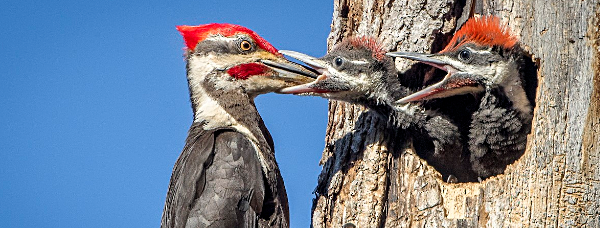- By Cornell Lab of Ornithology
- Around Town
 Print
Print  Pileated Woodpecker Photo by Shirley Donald
Pileated Woodpecker Photo by Shirley DonaldThe soothing power of nature can be a welcome antidote to uncertain times like these. Surveying birds during a wander in the woods or a ramble in the park is also an important way to assess how New York State's birds are faring. The third Breeding Bird Atlas survey is now underway and bird watchers are being asked to join this important effort. During the next five years, volunteers will gather information that scientists can then use to see what's changed for New York's breeding birds since the first survey was conducted in the 1980s. For the first time, participants will record their observations online through a special portal in the eBird program run by the Cornell Lab of Ornithology.
"This is a unique opportunity for anyone to learn about birds while contributing valuable data for conservation," said Julie Hart, atlas project coordinator at the New York Natural Heritage Program. "I encourage all bird enthusiasts to participate and tune in to the breeding birds that raise their families here in New York State."
The atlas is designed to determine when and where the state's nearly 250 species of birds are breeding. Volunteers record all the breeding species they observe in each atlas "block," which is a roughly 3-mile by 3-mile area. There are 5,710 blocks in the state.
"Data entry is easy. Anyone can create a free eBird account and submit data online through the atlas website or with the eBird mobile app," explained Ian Davies, eBird project leader at the Cornell Lab. "Simply record the species and any breeding behaviors observed."
Volunteers can choose a single block or go atlasing in any block. They just need to make sure each eBird checklist contains data for a single block. Atlasing is an activity that can be done alone or, if you do go with someone, be sure to stay at least six feet apart from non-household members to prevent the further spread of the coronavirus.
Trends highlighted by atlas data are used by the bird-watching community, researchers, land managers, and regulatory agencies to guide the management and conservation of birds and their habitats. For example, a comparison study between the first two atlases showed that the distribution of 129 species moved northward an average of 2.2 miles (3.58 kilometers), most likely due to climate change. Has that northward shift continued? Are some species declining? Are some doing better?
"The Breeding Bird Atlas helps our scientists answer essential questions that lead to real results for birds," said Audubon New York Executive Director Ana Paula Tavares. "Audubon has used atlas data to help identify Important Bird Areas and grassland bird focus areas, and to implement forest management where it provides the greatest help to woodland birds. It's incredible to think that anyone, anywhere in New York, can help effect widespread change by entering simple data into eBird."
Anyone can participate in the atlas, even those who only know a few backyard birds.
v16i13



